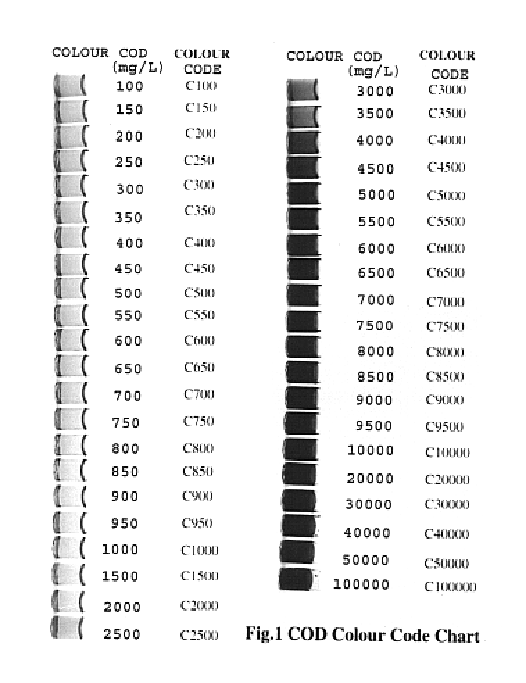Rapid method for estimation of Chemical Oxygen Demand
a technology of chemical oxygen demand and rapid estimation, which is applied in the direction of chemical methods analysis, chemical indicators, instruments, etc., can solve the problems of affecting fish and plant life, affecting the survival of aquatic life, and the oxygen supply in the water may be depleted below the level required for aquatic life, etc., to achieve rapid, rapid and onsite estimation of cod, and determine the efficiency of treatment plants
- Summary
- Abstract
- Description
- Claims
- Application Information
AI Technical Summary
Benefits of technology
Problems solved by technology
Method used
Image
Examples
example 1
[0116]Dissolved 0.5 and 5 g glucose in 50 mL distilled water, separately. Aliquots from the stock solutions were taken and diluted with water to achieve different concentrations in the range of 200 to 5000 (COD: 213 to 5335 mg / L) and 10000 to 100000 mg / L (COD: 10670 to 106700 mg / L), respectively. Weighed 0.02 g HgSO4 in separate 15 mL and 50 mL test tubes. 1.0 mL of glucose sample was added to each test tube and shake well. 0.5 ml of K2Cr2O7 was added to each sample. 1.5 mL H2SO4 silver sulphate reagent was added slowly with continuous shaking. The color of the reaction mixture was noted down visually within 1 min of incubation. The color varied with concentration. In 200 to 5000 mg / L glucose solutions, the color varied from C200 to C5000. At 5000 mg / L glucose and higher concentrations, the final color was always turbid. However, at concentration above 10000 mg / L glucose concentrations, the final color was always brown (C10000) and turbid. Hence for a preliminary estimate of COD val...
example 2
[0118]Dissolved 0.5 and 5 g glucose in 50 mL and 100 mL distilled water, respectively. Aliquots from the stock solutions were taken and diluted with water to achieve different concentrations in the range of 50 to 5000 (COD: 80 to 5335 mg / L) and 5500 to 100000 mg / L (COD: 5868 to 106700 mg / L), respectively. Weighed 0.02 g HgSO4 in separate 15 mL and 50 mL test tubes. 1.0 mL of glucose sample was added to each test tube and shake well. 0.5 mL of K2Cr2O7 was added to each sample. 1.5 mL H2SO4 silver sulphate reagent was added slowly with continuous shaking. The color of the reaction mixture was noted down visually within 1 min of incubation. The color varied with concentration. In 50 to 9500 mg / L glucose solutions, the color varied from C50 to C9500. At 5500 mg / L glucose and higher concentrations, the final color was always turbid. However, at concentration above 10000 mg / L glucose concentrations, the final color was always C10000. Hence, for a preliminary estimate of COD value, color o...
example 3
[0120]Dissolved g glucose in 50 ml distilled water. Aliquots from the stock solution were taken and diluted with water to achieve different concentrations in the range of 100 to 2000 mg / L (COD: 106.7 to 2134 mg / L). Weighed 0.02 g HgSO4 in separate 15 mL and 25 mL test tubes. 1.0 ml of glucose sample was added to each test tube and shake well. 0.5 ml of K2Cr2O7 was added to each sample. 1.5 ml H2SO4 silver Sulphate reagent was added slowly with continuous shaking. The color of the reaction mixture was noted down visually within 1 min of incubation and also recorded spectrophotometrically at 585 and 635 nm against air. The color varied with concentration. In 100 to 2000 mg / L glucose solutions, the color varied from C100 to C2000. At 100 to 800 mg / L glucose concentrations, OD 585 varied from 0.104 to 0.307 and OD 585 and OD 635 varied from 0.092 to 0.276. In the COD range of 106.7 to 640.2 mg / L the OD 585 and OD 635 there was an incremental difference of 0.030 and 0.027 each 106.7 mg / L...
PUM
| Property | Measurement | Unit |
|---|---|---|
| concentration | aaaaa | aaaaa |
| concentration | aaaaa | aaaaa |
| COD | aaaaa | aaaaa |
Abstract
Description
Claims
Application Information
 Login to view more
Login to view more - R&D Engineer
- R&D Manager
- IP Professional
- Industry Leading Data Capabilities
- Powerful AI technology
- Patent DNA Extraction
Browse by: Latest US Patents, China's latest patents, Technical Efficacy Thesaurus, Application Domain, Technology Topic.
© 2024 PatSnap. All rights reserved.Legal|Privacy policy|Modern Slavery Act Transparency Statement|Sitemap

